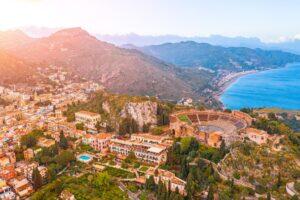Fodor's Expert Review Parco Archeologico della Neapolis
Siracusa is most famous for its dramatic set of Greek and Roman ruins, which are considered to be some of the best archaeological sites in all of Italy and should be combined with a stop at the Museo Archeologico. If the park is closed, go up Viale G. Rizzo from Viale Teracati to the belvedere overlooking the ruins, which are floodlit at night.
Before the park's ticket booth is the gigantic Ara di Ierone (Altar of Hieron), which was once used by the Greeks for spectacular sacrifices involving hundreds of animals. The first attraction in the park is the Latomia del Paradiso (Quarry of Paradise), a lush tropical garden full of palm and citrus trees. This series of quarries served as prisons for the defeated Athenians, who were enslaved; the quarries once rang with the sound of their chisels and hammers. At one end is the famous Orecchio di Dionisio (Ear of Dionysius), with an ear-shape entrance and unusual acoustics inside, as you'll hear if you clap your hands.... READ MORE
Siracusa is most famous for its dramatic set of Greek and Roman ruins, which are considered to be some of the best archaeological sites in all of Italy and should be combined with a stop at the Museo Archeologico. If the park is closed, go up Viale G. Rizzo from Viale Teracati to the belvedere overlooking the ruins, which are floodlit at night.
Before the park's ticket booth is the gigantic Ara di Ierone (Altar of Hieron), which was once used by the Greeks for spectacular sacrifices involving hundreds of animals. The first attraction in the park is the Latomia del Paradiso (Quarry of Paradise), a lush tropical garden full of palm and citrus trees. This series of quarries served as prisons for the defeated Athenians, who were enslaved; the quarries once rang with the sound of their chisels and hammers. At one end is the famous Orecchio di Dionisio (Ear of Dionysius), with an ear-shape entrance and unusual acoustics inside, as you'll hear if you clap your hands. The legend is that Dionysius used to listen in at the top of the quarry to hear what the enslaved people were plotting below.
The Teatro Greco is the chief monument in the Archaeological Park. Indeed it's one of Sicily's greatest classical sites and the most complete Greek theater surviving from antiquity. Climb to the top of the seating area (which could accommodate 15,000) for a fine view: all the seats converge upon a single point—the stage—which has the natural scenery and the sky as its backdrop. Hewn out of the hillside rock in the 5th century BC, the theater saw the premieres of the plays of Aeschylus, and Greek tragedies are still performed here every year in May and June. Above and behind the theater runs the Via dei Sepulcri, in which streams of running water flow through a series of Greek sepulchers.
The well-preserved and striking Anfiteatro Romano (Roman Amphitheater) reveals much about the differences between the Greek and Roman personalities. Where drama in the Greek theater was a kind of religious ritual, the Roman amphitheater emphasized the spectacle of combative sports and the circus. This arena is one of the largest of its kind and was built around the 2nd century AD. The corridor where gladiators and beasts entered the ring is still intact, and the seats (some of which still bear the occupants' names) were hauled in and constructed on the site from huge slabs of limestone.
READ LESS








